TOYOTA YARIS 2021 Owners Manual
Manufacturer: TOYOTA, Model Year: 2021, Model line: YARIS, Model: TOYOTA YARIS 2021Pages: 568, PDF Size: 110.34 MB
Page 261 of 568
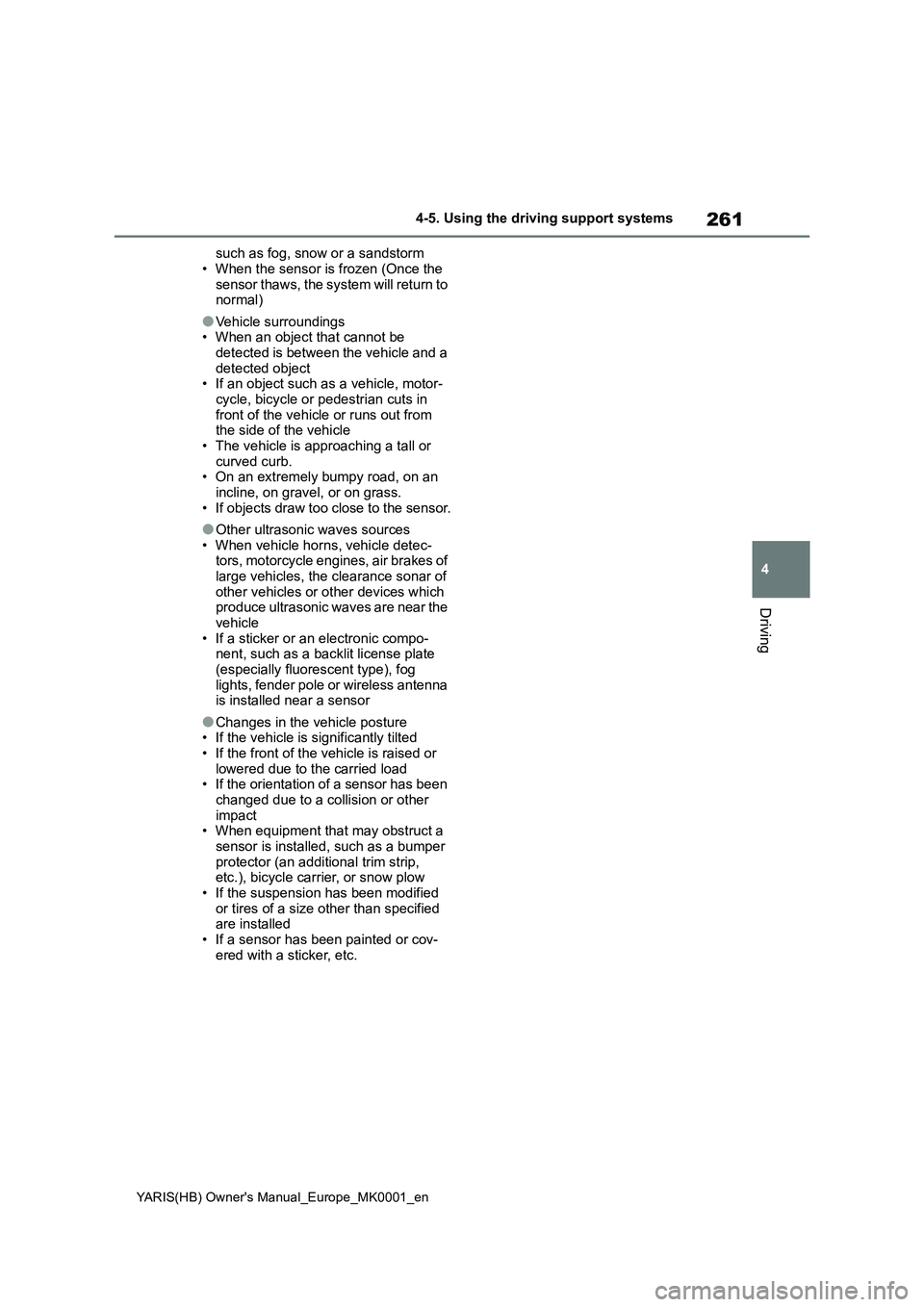
261
4
YARIS(HB) Owner's Manual_Europe_MK0001_en
4-5. Using the driving support systems
Driving
such as fog, snow or a sandstorm
• When the sensor is frozen (Once the
sensor thaws, the system will return to
normal)
●Vehicle surroundings
• When an object that cannot be
detected is between the vehicle and a
detected object
• If an object such as a vehicle, motor-
cycle, bicycle or pedestrian cuts in
front of the vehicle or runs out from
the side of the vehicle
• The vehicle is approaching a tall or
curved curb.
• On an extremely bumpy road, on an
incline, on gravel, or on grass.
• If objects draw too close to the sensor.
●Other ultrasonic waves sources
• When vehicle horns, vehicle detec-
tors, motorcycle engines, air brakes of
large vehicles, the clearance sonar of
other vehicles or other devices which
produce ultrasonic waves are near the
vehicle
• If a sticker or an electronic compo-
nent, such as a backlit license plate
(especially fluorescent type), fog
lights, fender pole or wireless antenna
is installed near a sensor
●Changes in the vehicle posture
• If the vehicle is significantly tilted
• If the front of the vehicle is raised or
lowered due to the carried load
• If the orientation of a sensor has been
changed due to a collision or other
impact
• When equipment that may obstruct a
sensor is installed, such as a bumper
protector (an additional trim strip,
etc.), bicycle carrier, or snow plow
• If the suspension has been modified
or tires of a size other than specified
are installed
• If a sensor has been painted or cov-
ered with a sticker, etc.
Page 262 of 568
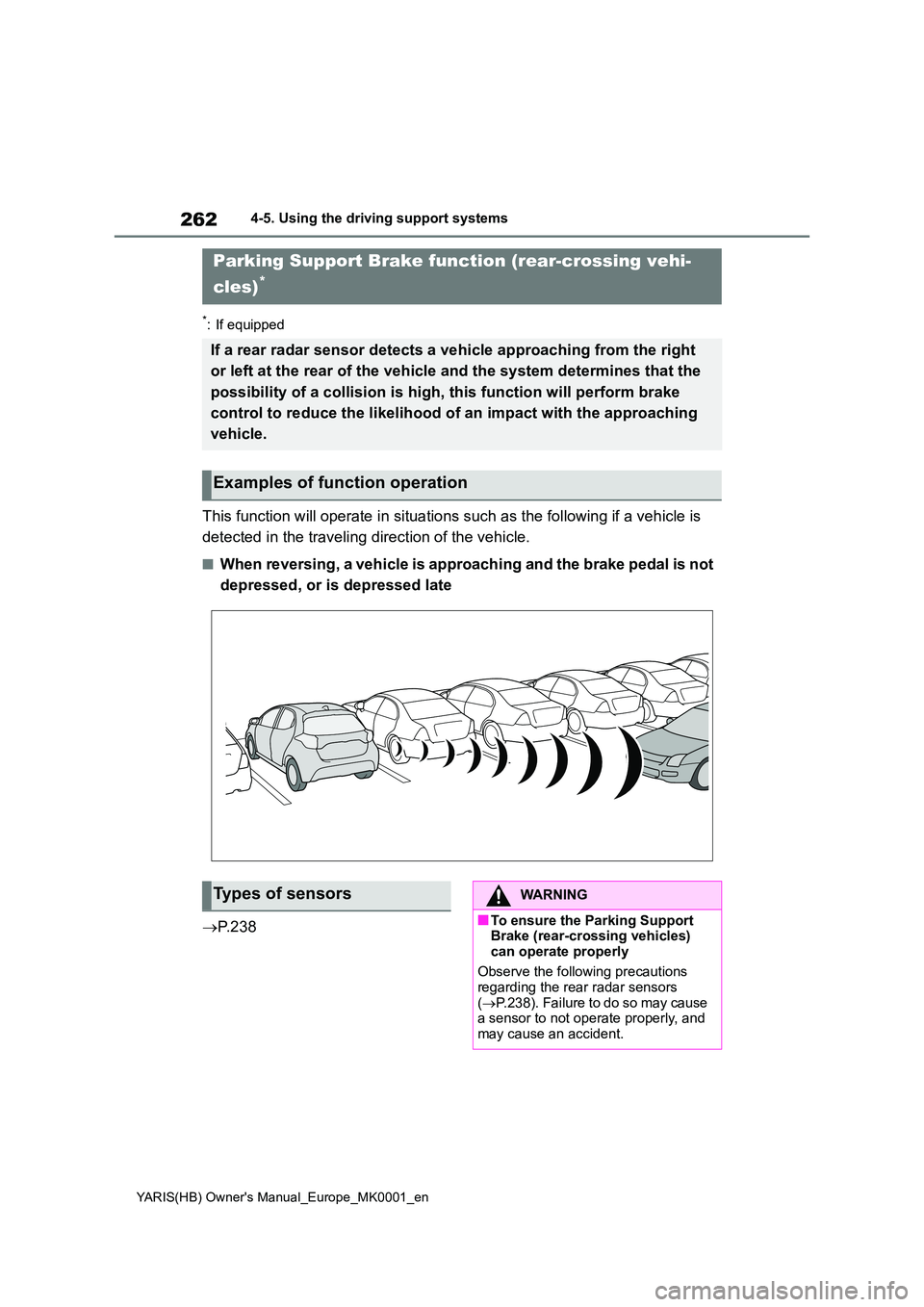
262
YARIS(HB) Owner's Manual_Europe_MK0001_en
4-5. Using the driving support systems
*: If equipped
This function will operate in situations such as the following if a vehicle is
detected in the traveling direction of the vehicle.
■When reversing, a vehicle is approaching and the brake pedal is not
depressed, or is depressed late
→ P. 2 3 8
Parking Support Brake function (rear-crossing vehi-
cles)*
If a rear radar sensor detects a vehicle approaching from the right
or left at the rear of the vehicle and the system determines that the
possibility of a collision is high, this function will perform brake
control to reduce the likelihood of an impact with the approaching
vehicle.
Examples of function operation
Types of sensorsWARNING
■To ensure the Parking Support Brake (rear-crossing vehicles)
can operate properly
Observe the following precautions regarding the rear radar sensors
( →P.238). Failure to do so may cause a sensor to not operate properly, and may cause an accident.
Page 263 of 568
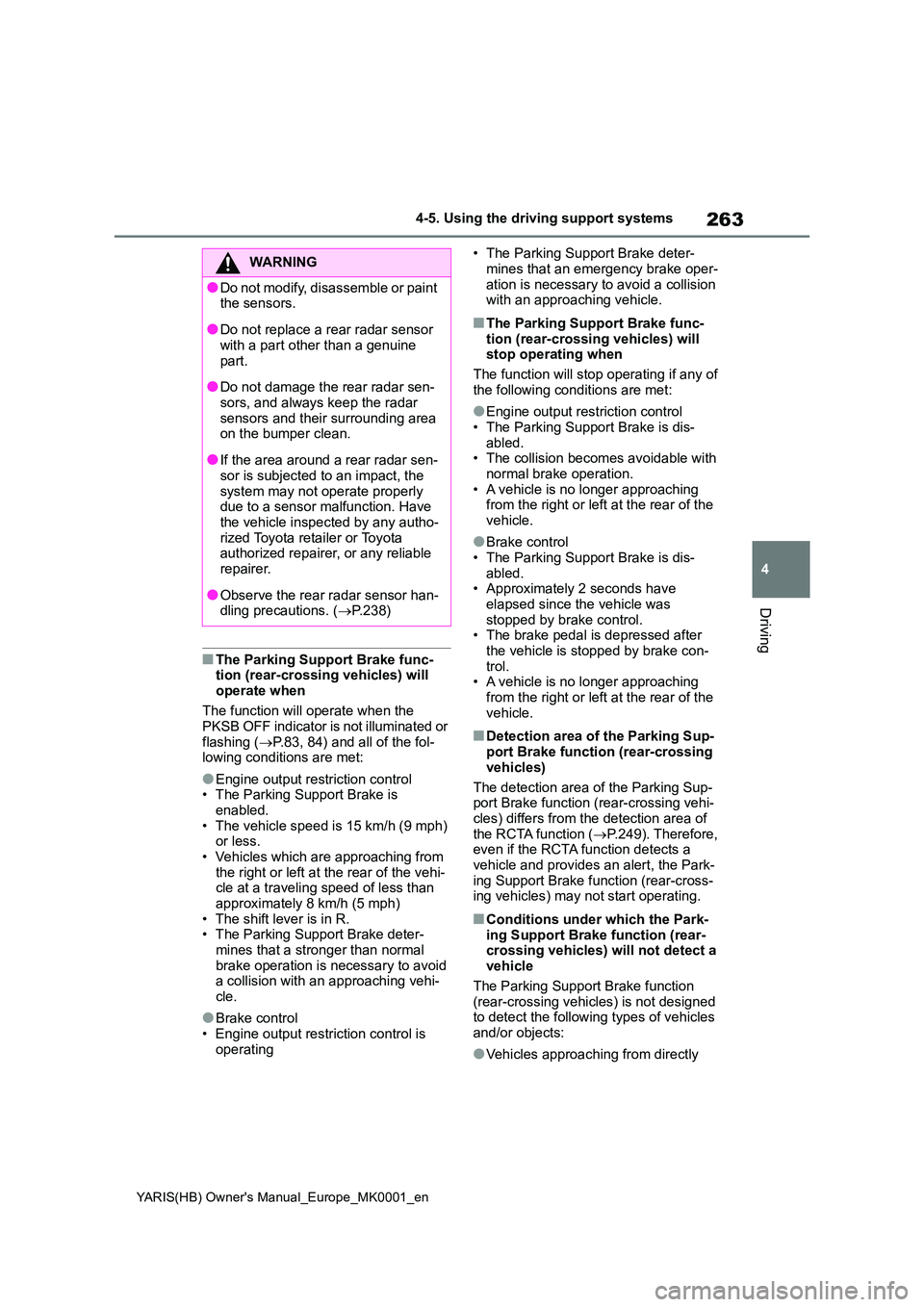
263
4
YARIS(HB) Owner's Manual_Europe_MK0001_en
4-5. Using the driving support systems
Driving
■The Parking Support Brake func- tion (rear-crossing vehicles) will
operate when
The function will operate when the PKSB OFF indicator is not illuminated or
flashing ( →P.83, 84) and all of the fol- lowing conditions are met:
●Engine output restriction control• The Parking Support Brake is enabled.
• The vehicle speed is 15 km/h (9 mph) or less.• Vehicles which are approaching from
the right or left at the rear of the vehi- cle at a traveling speed of less than approximately 8 km/h (5 mph)
• The shift lever is in R. • The Parking Support Brake deter-mines that a stronger than normal
brake operation is necessary to avoid a collision with an approaching vehi-cle.
●Brake control• Engine output restriction control is
operating
• The Parking Support Brake deter-
mines that an emergency brake oper- ation is necessary to avoid a collision with an approaching vehicle.
■The Parking Support Brake func-
tion (rear-crossing vehicles) will stop operating when
The function will stop operating if any of
the following conditions are met:
●Engine output restriction control
• The Parking Support Brake is dis- abled.• The collision becomes avoidable with
normal brake operation. • A vehicle is no longer approaching from the right or left at the rear of the
vehicle.
●Brake control
• The Parking Support Brake is dis- abled.• Approximately 2 seconds have
elapsed since the vehicle was stopped by brake control.• The brake pedal is depressed after
the vehicle is stopped by brake con- trol.• A vehicle is no longer approaching
from the right or left at the rear of the vehicle.
■Detection area of the Parking Sup-port Brake function (rear-crossing
vehicles)
The detection area of the Parking Sup- port Brake function (rear-crossing vehi-
cles) differs from the detection area of the RCTA function ( →P.249). Therefore, even if the RCTA function detects a
vehicle and provides an alert, the Park- ing Support Brake function (rear-cross-ing vehicles) may not start operating.
■Conditions under which the Park-
ing Support Brake function (rear- crossing vehicles) will not detect a vehicle
The Parking Support Brake function (rear-crossing vehicles) is not designed to detect the following types of vehicles
and/or objects:
●Vehicles approaching from directly
WARNING
●Do not modify, disassemble or paint the sensors.
●Do not replace a rear radar sensor with a part other than a genuine
part.
●Do not damage the rear radar sen-
sors, and always keep the radar sensors and their surrounding area on the bumper clean.
●If the area around a rear radar sen-sor is subjected to an impact, the
system may not operate properly due to a sensor malfunction. Have the vehicle inspected by any autho-
rized Toyota retailer or Toyota authorized repairer, or any reliable repairer.
●Observe the rear radar sensor han-dling precautions. ( →P.238)
Page 264 of 568
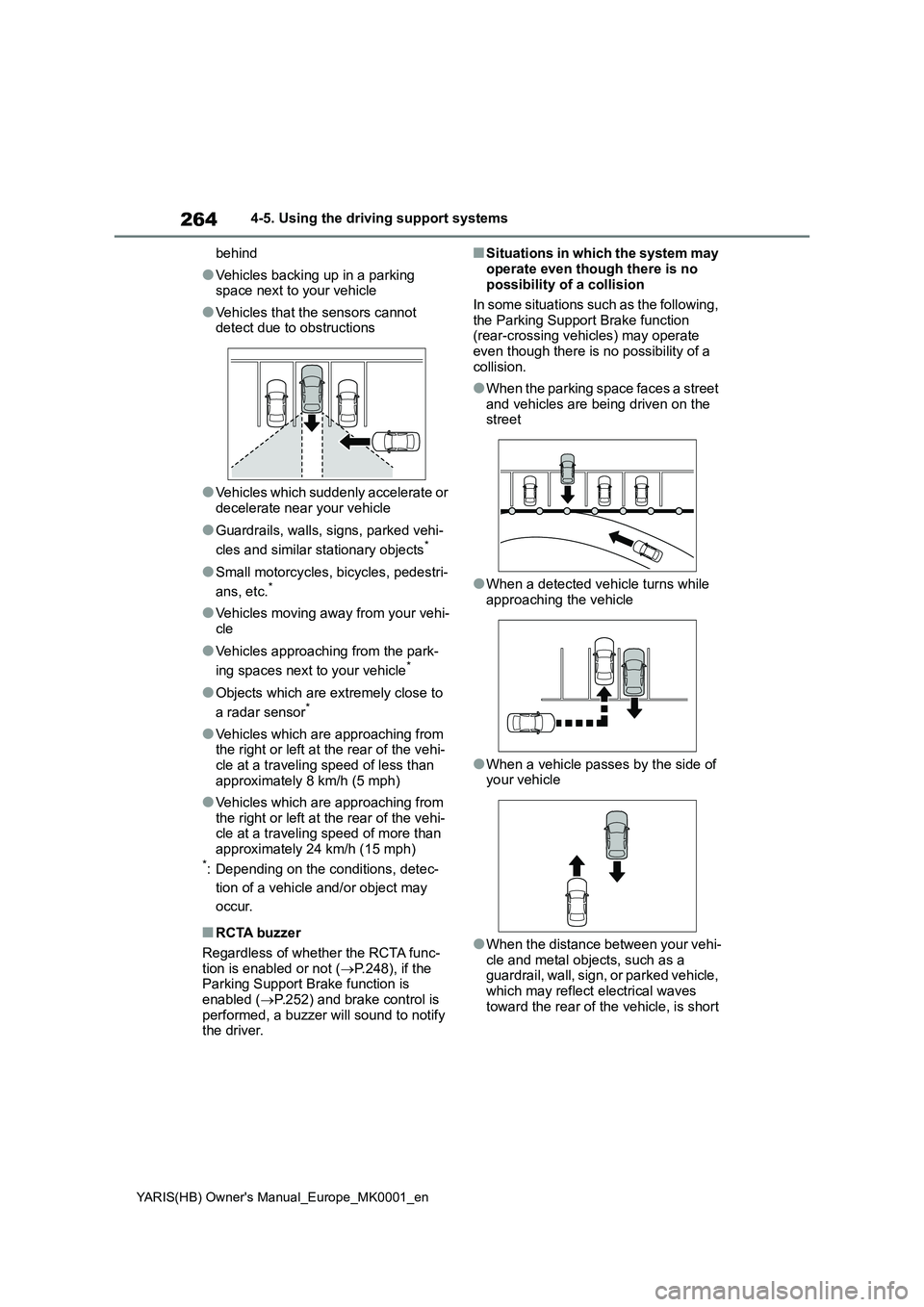
264
YARIS(HB) Owner's Manual_Europe_MK0001_en
4-5. Using the driving support systems
behind
●Vehicles backing up in a parking space next to your vehicle
●Vehicles that the sensors cannot detect due to obstructions
●Vehicles which suddenly accelerate or decelerate near your vehicle
●Guardrails, walls, signs, parked vehi-
cles and similar stationary objects*
●Small motorcycles, bicycles, pedestri-
ans, etc.*
●Vehicles moving away from your vehi-
cle
●Vehicles approaching from the park-
ing spaces next to your vehicle*
●Objects which are extremely close to
a radar sensor*
●Vehicles which are approaching from the right or left at the rear of the vehi-cle at a traveling speed of less than
approximately 8 km/h (5 mph)
●Vehicles which are approaching from
the right or left at the rear of the vehi- cle at a traveling speed of more than approximately 24 km/h (15 mph)*: Depending on the conditions, detec-
tion of a vehicle and/or object may
occur.
■RCTA buzzer
Regardless of whether the RCTA func- tion is enabled or not ( →P.248), if the Parking Support Brake function is
enabled ( →P.252) and brake control is performed, a buzzer will sound to notify the driver.
■Situations in which the system may
operate even though there is no possibility of a collision
In some situations such as the following,
the Parking Support Brake function (rear-crossing vehicles) may operate even though there is no possibility of a
collision.
●When the parking space faces a street
and vehicles are being driven on the street
●When a detected vehicle turns while approaching the vehicle
●When a vehicle passes by the side of your vehicle
●When the distance between your vehi-cle and metal objects, such as a guardrail, wall, sign, or parked vehicle,
which may reflect electrical waves toward the rear of the vehicle, is short
Page 265 of 568
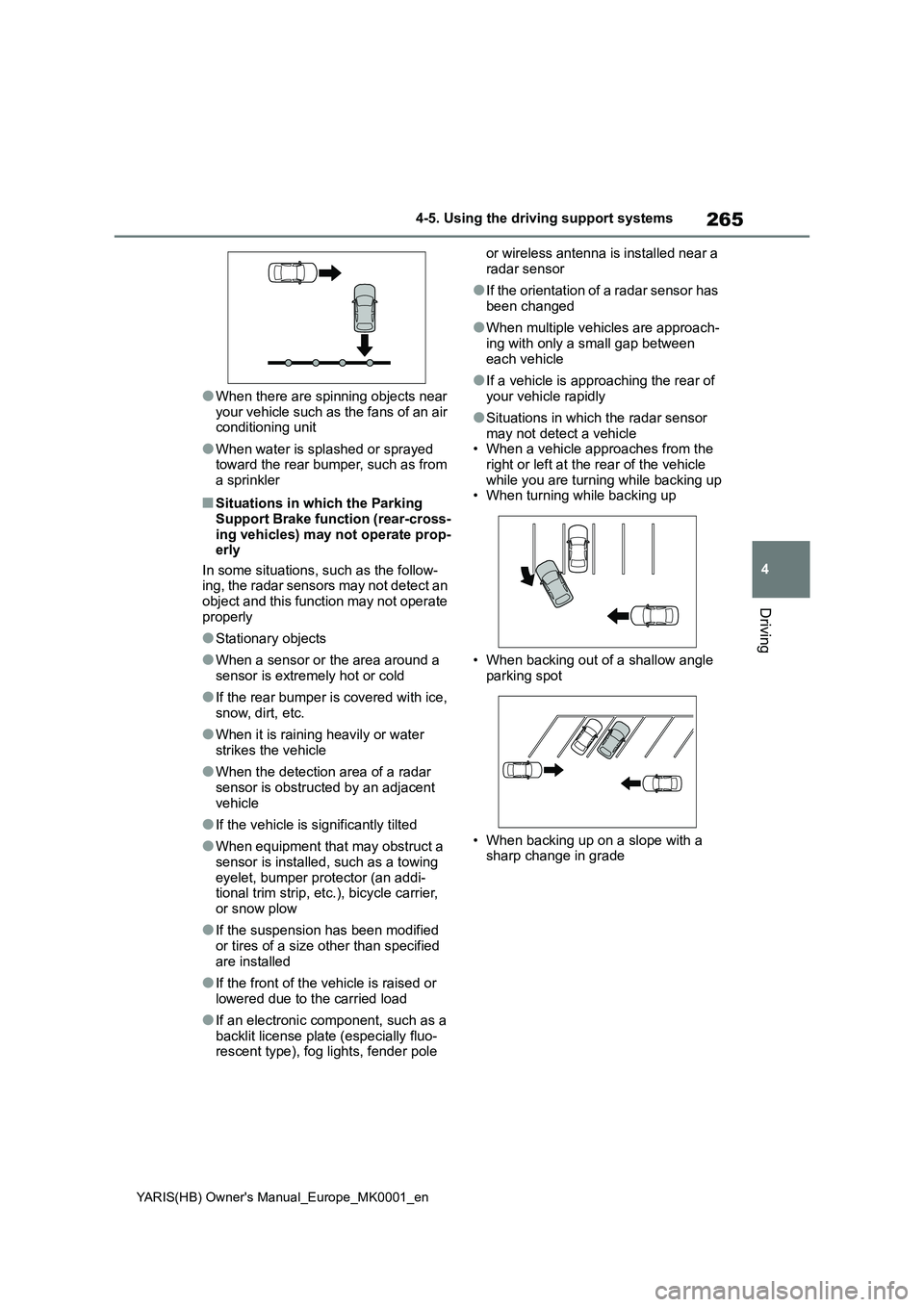
265
4
YARIS(HB) Owner's Manual_Europe_MK0001_en
4-5. Using the driving support systems
Driving
●When there are spinning objects near
your vehicle such as the fans of an air conditioning unit
●When water is splashed or sprayed toward the rear bumper, such as from a sprinkler
■Situations in which the Parking
Support Brake function (rear-cross- ing vehicles) may not operate prop-erly
In some situations, such as the follow- ing, the radar sensors may not detect an object and this function may not operate
properly
●Stationary objects
●When a sensor or the area around a sensor is extremely hot or cold
●If the rear bumper is covered with ice, snow, dirt, etc.
●When it is raining heavily or water strikes the vehicle
●When the detection area of a radar sensor is obstructed by an adjacent
vehicle
●If the vehicle is significantly tilted
●When equipment that may obstruct a sensor is installed, such as a towing
eyelet, bumper protector (an addi- tional trim strip, etc.), bicycle carrier, or snow plow
●If the suspension has been modified or tires of a size other than specified
are installed
●If the front of the vehicle is raised or
lowered due to the carried load
●If an electronic component, such as a
backlit license plate (especially fluo- rescent type), fog lights, fender pole
or wireless antenna is installed near a
radar sensor
●If the orientation of a radar sensor has
been changed
●When multiple vehicles are approach-
ing with only a small gap between each vehicle
●If a vehicle is approaching the rear of your vehicle rapidly
●Situations in which the radar sensor may not detect a vehicle• When a vehicle approaches from the
right or left at the rear of the vehicle while you are turning while backing up• When turning while backing up
• When backing out of a shallow angle parking spot
• When backing up on a slope with a sharp change in grade
Page 266 of 568
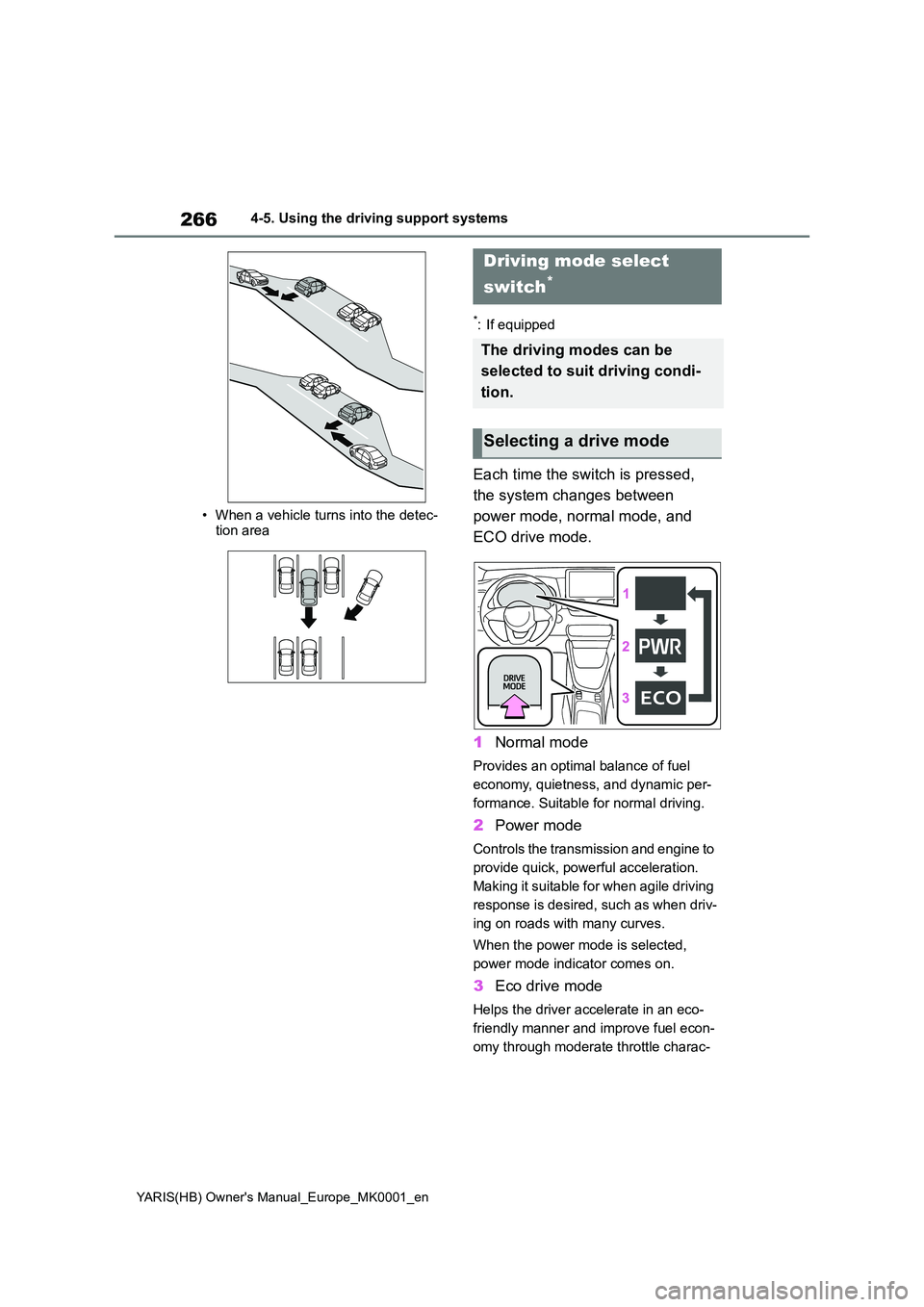
266
YARIS(HB) Owner's Manual_Europe_MK0001_en
4-5. Using the driving support systems
• When a vehicle turns into the detec- tion area
*: If equipped
Each time the switch is pressed,
the system changes between
power mode, normal mode, and
ECO drive mode.
1 Normal mode
Provides an optimal balance of fuel
economy, quietness, and dynamic per-
formance. Suitable for normal driving.
2 Power mode
Controls the transmission and engine to
provide quick, powerful acceleration.
Making it suitable for when agile driving
response is desired, such as when driv-
ing on roads with many curves.
When the power mode is selected,
power mode indicator comes on.
3 Eco drive mode
Helps the driver accelerate in an eco-
friendly manner and improve fuel econ-
omy through moderate throttle charac-
Driving mode select
switch*
The driving modes can be
selected to suit driving condi-
tion.
Selecting a drive mode
Page 267 of 568
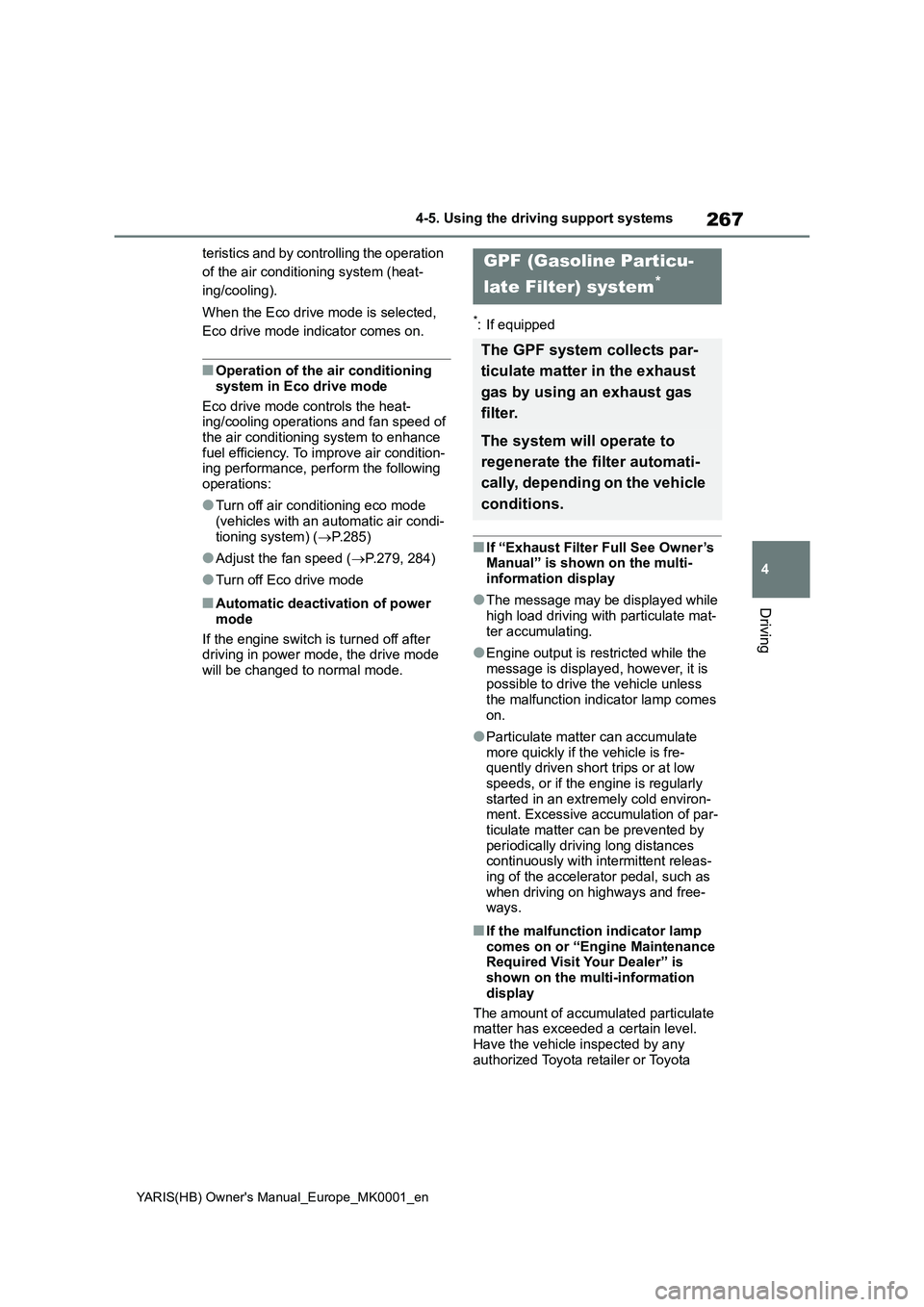
267
4
YARIS(HB) Owner's Manual_Europe_MK0001_en
4-5. Using the driving support systems
Driving
teristics and by controlling the operation
of the air conditioning system (heat-
ing/cooling).
When the Eco drive mode is selected,
Eco drive mode indicator comes on.
■Operation of the air conditioning
system in Eco drive mode
Eco drive mode controls the heat-
ing/cooling operations and fan speed of
the air conditioning system to enhance
fuel efficiency. To improve air condition-
ing performance, perform the following
operations:
●Turn off air conditioning eco mode
(vehicles with an automatic air condi-
tioning system) (→P.285)
●Adjust the fan speed (→P.279, 284)
●Turn off Eco drive mode
■Automatic deactivation of power
mode
If the engine switch is turned off after
driving in power mode, the drive mode
will be changed to normal mode.
*: If equipped
■If “Exhaust Filter Full See Owner’s
Manual” is shown on the multi-
information display
●The message may be displayed while
high load driving with particulate mat-
ter accumulating.
●Engine output is restricted while the
message is displayed, however, it is
possible to drive the vehicle unless
the malfunction indicator lamp comes
on.
●Particulate matter can accumulate
more quickly if the vehicle is fre-
quently driven short trips or at low
speeds, or if the engine is regularly
started in an extremely cold environ-
ment. Excessive accumulation of par-
ticulate matter can be prevented by
periodically driving long distances
continuously with intermittent releas-
ing of the accelerator pedal, such as
when driving on highways and free-
ways.
■If the malfunction indicator lamp
comes on or “Engine Maintenance
Required Visit Your Dealer” is
shown on the multi-information
display
The amount of accumulated particulate
matter has exceeded a certain level.
Have the vehicle inspected by any
authorized Toyota retailer or Toyota
GPF (Gasoline Particu-
late Filter) system
*
The GPF system collects par-
ticulate matter in the exhaust
gas by using an exhaust gas
filter.
The system will operate to
regenerate the filter automati-
cally, depending on the vehicle
conditions.
Page 268 of 568
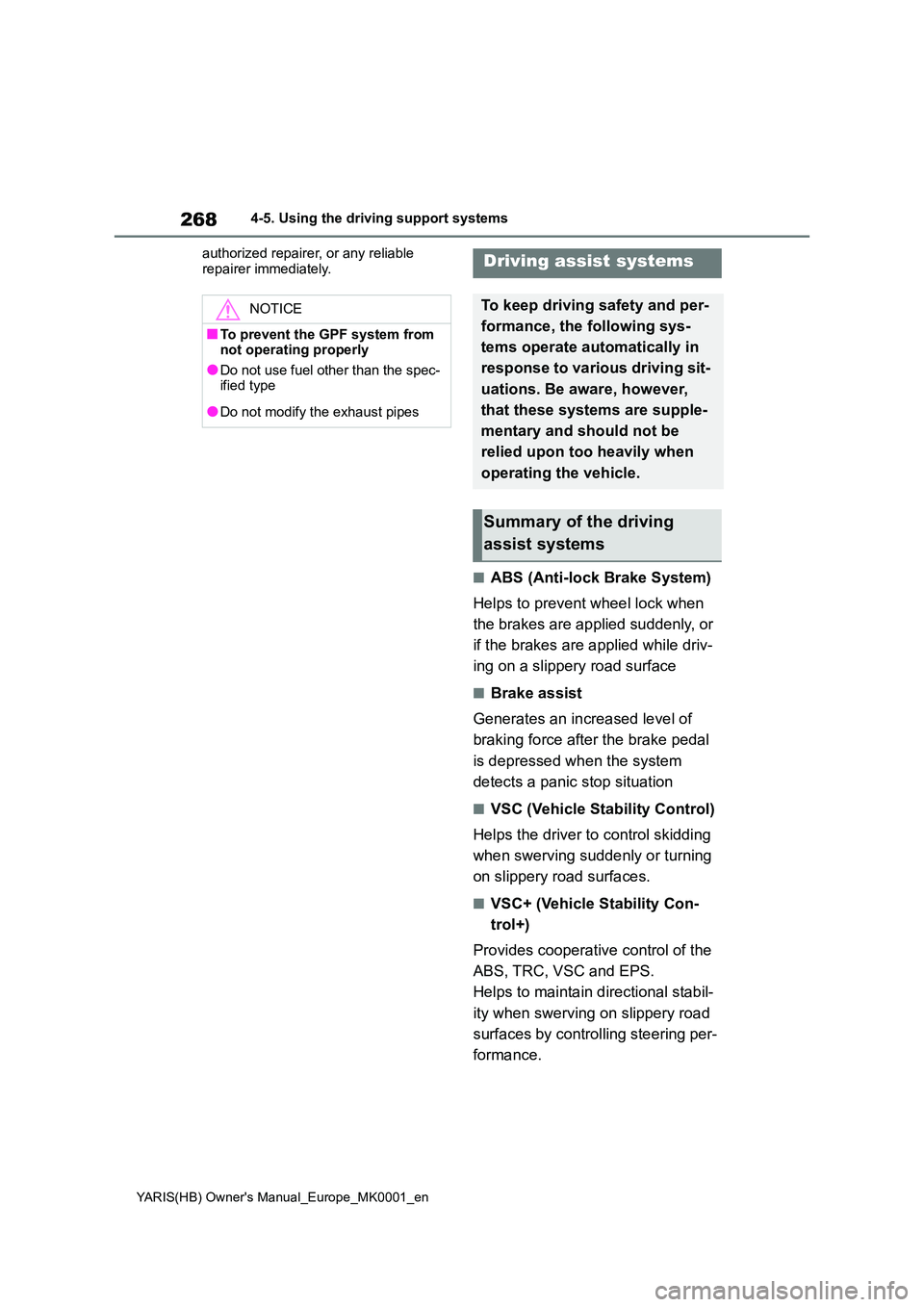
268
YARIS(HB) Owner's Manual_Europe_MK0001_en
4-5. Using the driving support systems
authorized repairer, or any reliable
repairer immediately.
■ABS (Anti-lock Brake System)
Helps to prevent wheel lock when
the brakes are applied suddenly, or
if the brakes are applied while driv-
ing on a slippery road surface
■Brake assist
Generates an increased level of
braking force after the brake pedal
is depressed when the system
detects a panic stop situation
■VSC (Vehicle Stability Control)
Helps the driver to control skidding
when swerving suddenly or turning
on slippery road surfaces.
■VSC+ (Vehicle Stability Con-
trol+)
Provides cooperative control of the
ABS, TRC, VSC and EPS.
Helps to maintain directional stabil-
ity when swerving on slippery road
surfaces by controlling steering per-
formance.
NOTICE
■To prevent the GPF system from not operating properly
●Do not use fuel other than the spec-ified type
●Do not modify the exhaust pipes
Driving assist systems
To keep driving safety and per-
formance, the following sys-
tems operate automatically in
response to various driving sit-
uations. Be aware, however,
that these systems are supple-
mentary and should not be
relied upon too heavily when
operating the vehicle.
Summary of the driving
assist systems
Page 269 of 568
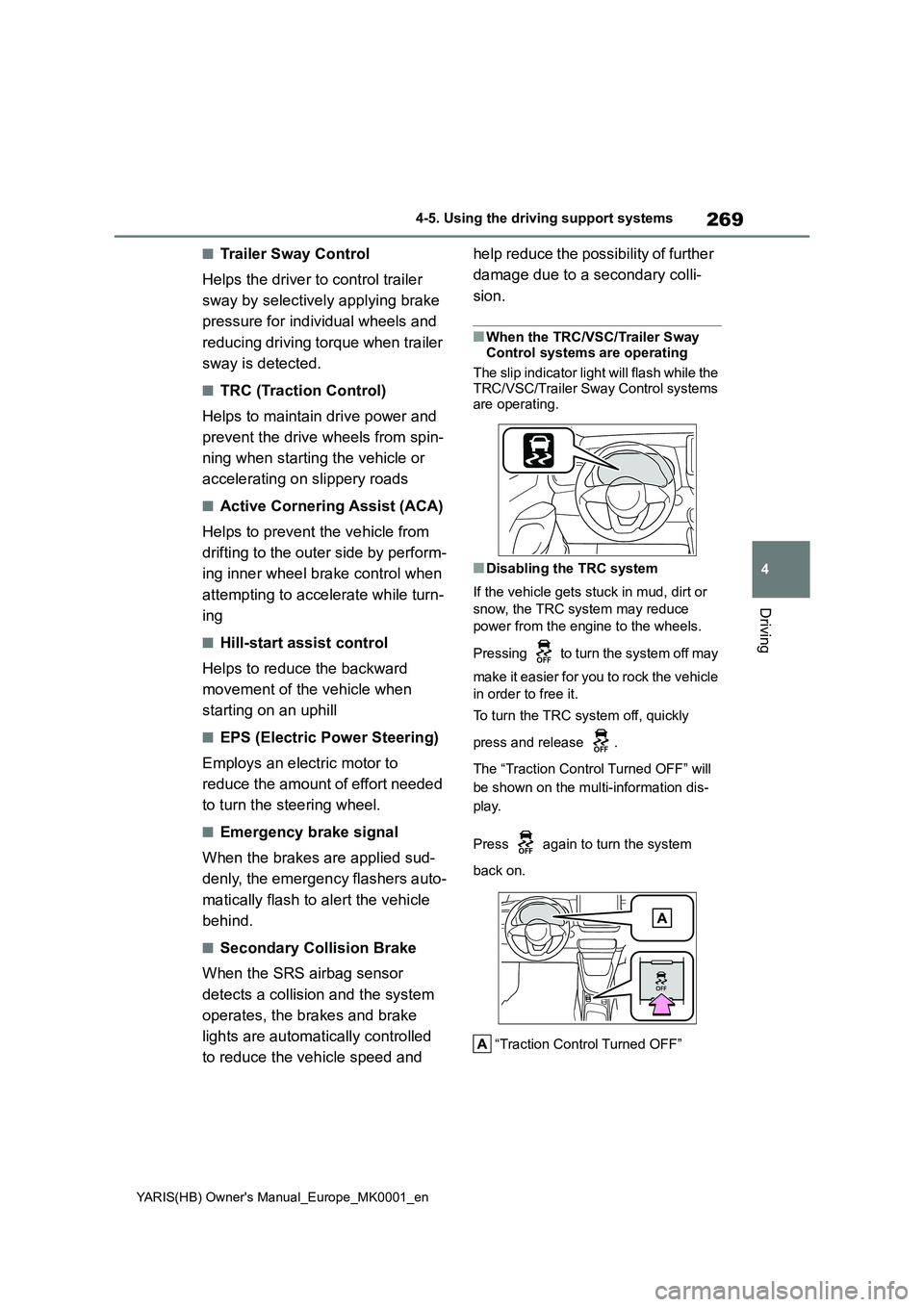
269
4
YARIS(HB) Owner's Manual_Europe_MK0001_en
4-5. Using the driving support systems
Driving
■Trailer Sway Control
Helps the driver to control trailer
sway by selectively applying brake
pressure for individual wheels and
reducing driving torque when trailer
sway is detected.
■TRC (Traction Control)
Helps to maintain drive power and
prevent the drive wheels from spin-
ning when starting the vehicle or
accelerating on slippery roads
■Active Cornering Assist (ACA)
Helps to prevent the vehicle from
drifting to the outer side by perform-
ing inner wheel brake control when
attempting to accelerate while turn-
ing
■Hill-start assist control
Helps to reduce the backward
movement of the vehicle when
starting on an uphill
■EPS (Electric Power Steering)
Employs an electric motor to
reduce the amount of effort needed
to turn the steering wheel.
■Emergency brake signal
When the brakes are applied sud-
denly, the emergency flashers auto-
matically flash to alert the vehicle
behind.
■Secondary Collision Brake
When the SRS airbag sensor
detects a collision and the system
operates, the brakes and brake
lights are automatically controlled
to reduce the vehicle speed and help reduce the possibility of further
damage due to a secondary colli-
sion.
■When the TRC/VSC/Trailer Sway
Control systems are operating
The slip indicator light will flash while the
TRC/VSC/Trailer Sway Control systems
are operating.
■Disabling the TRC system
If the vehicle gets stuck in mud, dirt or
snow, the TRC system may reduce
power from the engine to the wheels.
Pressing to turn the system off may
make it easier for you to rock the vehicle
in order to free it.
To turn the TRC system off, quickly
press and release .
The “Traction Control Turned OFF” will
be shown on the multi-information dis-
play.
Press again to turn the system
back on.
“Traction Control Turned OFF”
Page 270 of 568
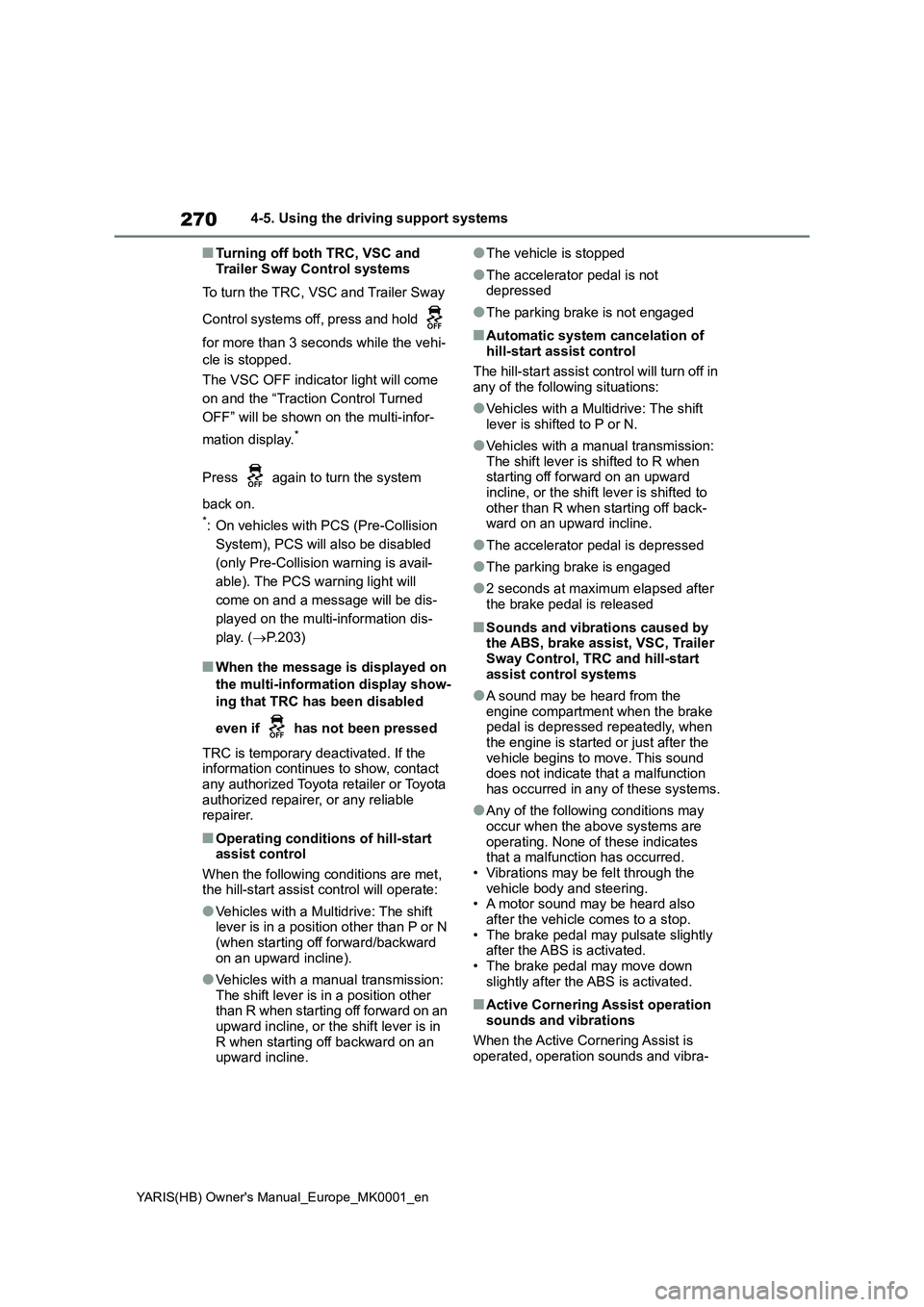
270
YARIS(HB) Owner's Manual_Europe_MK0001_en
4-5. Using the driving support systems
■Turning off both TRC, VSC and
Trailer Sway Control systems
To turn the TRC, VSC and Trailer Sway
Control systems off, press and hold
for more than 3 seconds while the vehi-
cle is stopped.
The VSC OFF indicator light will come
on and the “Traction Control Turned
OFF” will be shown on the multi-infor-
mation display.
*
Press again to turn the system
back on.
*: On vehicles with PCS (Pre-Collision
System), PCS will also be disabled
(only Pre-Collision warning is avail-
able). The PCS warning light will
come on and a message will be dis-
played on the multi-information dis-
play. (→P.203)
■When the message is displayed on
the multi-information display show-
ing that TRC has been disabled
even if has not been pressed
TRC is temporary deactivated. If the
information continues to show, contact
any authorized Toyota retailer or Toyota
authorized repairer, or any reliable
repairer.
■Operating conditions of hill-start
assist control
When the following conditions are met,
the hill-start assist control will operate:
●Vehicles with a Multidrive: The shift
lever is in a position other than P or N
(when starting off forward/backward
on an upward incline).
●Vehicles with a manual transmission:
The shift lever is in a position other
than R when starting off forward on an
upward incline, or the shift lever is in
R when starting off backward on an
upward incline.
●The vehicle is stopped
●The accelerator pedal is not
depressed
●The parking brake is not engaged
■Automatic system cancelation of
hill-start assist control
The hill-start assist control will turn off in
any of the following situations:
●Vehicles with a Multidrive: The shift
lever is shifted to P or N.
●Vehicles with a manual transmission:
The shift lever is shifted to R when
starting off forward on an upward
incline, or the shift lever is shifted to
other than R when starting off back-
ward on an upward incline.
●The accelerator pedal is depressed
●The parking brake is engaged
●2 seconds at maximum elapsed after
the brake pedal is released
■Sounds and vibrations caused by
the ABS, brake assist, VSC, Trailer
Sway Control, TRC and hill-start
assist control systems
●A sound may be heard from the
engine compartment when the brake
pedal is depressed repeatedly, when
the engine is started or just after the
vehicle begins to move. This sound
does not indicate that a malfunction
has occurred in any of these systems.
●Any of the following conditions may
occur when the above systems are
operating. None of these indicates
that a malfunction has occurred.
• Vibrations may be felt through the
vehicle body and steering.
• A motor sound may be heard also
after the vehicle comes to a stop.
• The brake pedal may pulsate slightly
after the ABS is activated.
• The brake pedal may move down
slightly after the ABS is activated.
■Active Cornering Assist operation
sounds and vibrations
When the Active Cornering Assist is
operated, operation sounds and vibra-